The prime minister of the United Kingdom is the principal minister of the crown of His Majesty's Government, and the head of the British Cabinet. There is no specific date for when the office of prime minister first appeared, as the role was not created but rather evolved over time through a merger of duties.[1] The term was regularly, if informally, used by Robert Walpole by the 1730s.[2] It was used in the House of Commons as early as 1805,[3] and it was certainly in parliamentary use by the 1880s,[4] although did not become the official title until 1905, when Arthur Balfour was prime minister.
Modern historians generally consider Robert Walpole, who led the government of the Kingdom of Great Britain for over twenty years from 1721,[5] to be the first prime minister. Walpole is also the longest-serving British prime minister by this definition.[6] By the same consideration, the first prime minister of the United Kingdom of Great Britain and Ireland was William Pitt the Younger at its creation on 1 January 1801.[7] The first to use the title in an official act was Benjamin Disraeli, who, in 1878, signed the Treaty of Berlin as "Prime Minister of Her Britannic Majesty".[8]
In 1905, the post of prime minister was officially given recognition in the order of precedence,[9] with the incumbent Henry Campbell-Bannerman the first officially referred to as "prime minister". The first prime minister of the current United Kingdom of Great Britain and Northern Ireland upon its effective creation in 1922 (when 26 Irish counties seceded and created the Irish Free State) was Bonar Law,[10] although the country was not renamed officially until 1927, when Stanley Baldwin was the serving prime minister.[11]
The incumbent prime minister is Keir Starmer, who assumed the office on 5 July 2024.
Before the Union of England and Scotland in 1707, the Treasury of England was led by the Lord High Treasurer.[12] By the late Tudor period, the Lord High Treasurer was regarded as one of the Great Officers of State,[12] and was often (though not always) the dominant figure in government: Edward Seymour, 1st Duke of Somerset (lord high treasurer, 1547–1549),[13] served as lord protector to his young nephew King Edward VI;[13] William Cecil, 1st Baron Burghley (lord high treasurer, 1572–1598),[14] was the dominant minister to Queen Elizabeth I;[14] Burghley's son Robert Cecil, 1st Earl of Salisbury, succeeded his father as Chief Minister to Elizabeth (1598–1603) and was eventually appointed by King James I as lord high treasurer (1608–1612).[15]
By the late Stuart period, the Treasury was often run not by a single individual (i.e., the lord high treasurer) but by a commission of lords of the Treasury,[16] led by the first lord of the Treasury. The last lords high treasurer, Sidney Godolphin, 1st Earl of Godolphin (1702–1710) and Robert Harley, 1st Earl of Oxford (1711–1714),[17] ran the government of Queen Anne.[18]
Following the succession of George I in 1714, the arrangement of a commission of lords of the Treasury (as opposed to a single lord high treasurer) became permanent.[19] For the next three years, the government was headed by Charles Townshend, 2nd Viscount Townshend, who was appointed Secretary of State for the Northern Department.[20] Subsequently, Lords Stanhope and Sunderland ran the government jointly,[21] with Stanhope managing foreign affairs and Sunderland domestic.[21] Stanhope died in February 1721 and Sunderland resigned two months later;[21] Townshend and Robert Walpole were then invited to form the next government.[22] From that point, the holder of the office of first lord also usually (albeit unofficially) held the status of prime minister. It was not until the Edwardian era that the title prime minister was constitutionally recognised.[23] The prime minister still holds the office of first lord by constitutional convention,[24] the only exceptions being Lords Chatham (1766–1768) and Salisbury (1885–1886, 1886–1892, 1895–1902).[25]
| Portrait | Prime minister Office (Lifespan)
|
Term of office | Mandate[a] | Ministerial offices held as prime minister | Party | Government | Monarch Reign
| |||
|---|---|---|---|---|---|---|---|---|---|---|
| Start | End | Duration | ||||||||
| | 
|
[26]
|
3 April 1721
|
11 February 1742
|
20 years, 315 days | 1722 | Whig | Walpole– |
George I r. 1714–1727
| |
| 1727 | George II r. 1727–1760
| |||||||||
| 1734 | Walpole | |||||||||
| 1741 | ||||||||||

|
[27]
|
16 February 1742
|
2 July 1743
|
1 year, 137 days[b] | — | Carteret | ||||

|
[28]
|
27 August 1743[c]
|
6 March 1754[c]
|
10 years, 192 days[b] | — | Broad Bottom I | ||||
| 1747 | Broad Bottom II | |||||||||

|
[29]
|
16 March 1754
|
11 November 1756
|
2 years, 241 days | 1754 | Newcastle I | ||||

|
[30]
|
16 November 1756
|
29 June 1757
|
226 days | — | Pitt– | ||||
| 1757 Caretaker | ||||||||||

|
[31]
|
29 June 1757
|
26 May 1762
|
4 years, 332 days | 1761 | Pitt– | ||||
| Bute– |
George III r. 1760–1820
| |||||||||
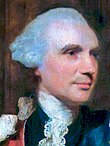
|
[32]
|
26 May 1762
|
8 April 1763
|
318 days | — | Tory | Bute | |||

|
[33]
|
16 April 1763
|
10 July 1765
|
2 years, 86 days | — | Whig | Grenville (mainly Whig)
| |||

|
[34]
|
13 July 1765
|
30 July 1766
|
1 year, 18 days | — | Whig | Rockingham I | |||

|
[35]
|
30 July 1766
|
14 October 1768
|
2 years, 77 days | 1768 | Whig | Chatham | |||
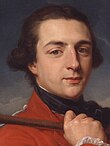
|
[36]
|
14 October 1768
|
28 January 1770
|
1 year, 107 days | — | Grafton | ||||

|
[37]
|
28 January 1770
|
27 March 1782
|
12 years, 59 days | 1774 | Tory (Northite)
|
North | |||
| 1780 | ||||||||||

|
[34]
|
27 March 1782
|
1 July 1782
|
97 days[b] | — | Whig | Rockingham II | |||

|
[38]
|
4 July 1782
|
26 March 1783
|
266 days | — | Whig | Shelburne | |||
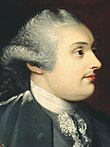
|
[39]
|
2 April 1783
|
18 December 1783
|
261 days | — | Whig | Fox–North | |||

|
[40]
|
19 December 1783
|
14 March 1801
|
17 years, 86 days | 1784 | Tory (Pittite)
|
Pitt I | |||
| 1790 | ||||||||||
| 1796 | ||||||||||

|
[41]
|
17 March 1801
|
10 May 1804
|
3 years, 55 days | 1801 | Tory | Addington | |||
| 1802 | ||||||||||

|
[42]
|
10 May 1804
|
23 January 1806
|
1 year, 259 days[b] | — | Tory (Pittite)
|
Pitt II | |||
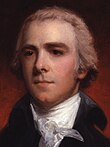
|
[43]
|
11 February 1806
|
25 March 1807
|
1 year, 43 days | 1806 | Whig | All the Talents | |||

|
[44]
|
31 March 1807
|
4 October 1809
|
2 years, 188 days | 1807 | Tory (Pittite)
|
Portland II | |||

|
[45]
|
4 October 1809
|
11 May 1812
|
2 years, 221 days[b] | — | Perceval | ||||

|
[46]
|
8 June 1812
|
9 April 1827
|
14 years, 306 days | 1812 | Liverpool | ||||
| 1818 | George IV r. 1820–1830
| |||||||||
| 1820 | ||||||||||
| 1826 | ||||||||||
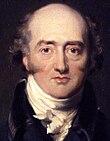
|
[47]
|
12 April 1827
|
8 August 1827
|
119 days[b] | — | Tory | Canning (Canningite–
| |||

|
[48]
|
31 August 1827
|
8 January 1828
|
131 days | — | Tory | Goderich | |||

|
[49]
|
22 January 1828
|
16 November 1830
|
2 years, 299 days | — | Tory | Wellington– | |||
| (1830) | William IV r. 1830–1837
| |||||||||

|
[50]
|
22 November 1830
|
9 July 1834
|
3 years, 230 days | 1831 | Whig | Grey | |||
| 1832 | ||||||||||
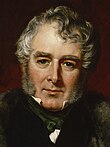
|
[51]
|
16 July 1834
|
14 November 1834
|
122 days | — | Melbourne I | ||||

|
[52]
|
17 November 1834
|
9 December 1834
|
23 days | (—) | Tory | Wellington Caretaker | |||

|
[53]
|
10 December 1834
|
8 April 1835
|
120 days | (—) | Conservative | Peel I | |||

|
[54]
|
18 April 1835
|
30 August 1841
|
6 years, 135 days | 1835 | Whig | Melbourne II | |||
| 1837 | Victoria r. 1837–1901
| |||||||||

|
[53]
|
30 August 1841
|
29 June 1846
|
4 years, 304 days | 1841 | Conservative | Peel II | |||

|
[55]
|
30 June 1846
|
21 February 1852
|
5 years, 237 days | (1847) | Whig | Russell I | |||

|
[56]
|
23 February 1852
|
17 December 1852
|
299 days | 1852 | Conservative | Who? Who? | |||

|
[57]
|
19 December 1852
|
30 January 1855
|
2 years, 43 days | (—) | Peelite | Aberdeen | |||

|
[58]
|
6 February 1855
|
19 February 1858
|
3 years, 14 days | 1857 | Whig | Palmerston I | |||

|
[59]
|
20 February 1858
|
11 June 1859
|
1 year, 112 days | (—) | Conservative | Derby– | |||

|
[60]
|
12 June 1859
|
18 October 1865
|
6 years, 129 days[b] | 1859 | Liberal | Palmerston II | |||
| 1865 | ||||||||||

|
[55]
|
29 October 1865
|
26 June 1866
|
241 days | — | Russell II | ||||

|
[61]
|
28 June 1866
|
25 February 1868
|
1 year, 243 days | (—) | Conservative | Derby– | |||

|
[62]
|
27 February 1868
|
1 December 1868
|
279 days | (—) | |||||

|
[63]
|
3 December 1868
|
17 February 1874
|
5 years, 77 days | 1868 |
|
Liberal | Gladstone I | ||

|
[64]
|
20 February 1874
|
21 April 1880
|
6 years, 62 days | 1874 | Conservative | Disraeli II | |||

|
[65]
|
23 April 1880
|
9 June 1885
|
5 years, 48 days | 1880 |
|
Liberal | Gladstone II | ||

|
[66]
|
23 June 1885
|
28 January 1886
|
220 days | (—) | Conservative | Salisbury I | |||

|
[65]
|
1 February 1886
|
20 July 1886
|
170 days | (1885) | Liberal | Gladstone III | |||

|
[67]
|
25 July 1886
|
11 August 1892
|
6 years, 18 days | (1886) |
|
Conservative | Salisbury II | ||

|
[65]
|
15 August 1892
|
2 March 1894
|
1 year, 200 days | (1892) | Liberal | Gladstone IV | |||

|
[68]
|
5 March 1894
|
22 June 1895
|
1 year, 110 days | (—) | Rosebery | ||||

|
[69]
|
25 June 1895
|
11 July 1902
|
7 years, 17 days | 1895 |
|
Conservative | Salisbury III | ||
| 1900 | Salisbury IV (Con–
| |||||||||
Edward VII r. 1901–1910
| ||||||||||

|
[70]
|
12 July 1902
|
4 December 1905
|
3 years, 146 days | — | Balfour (Con–
| ||||

|
[71]
|
5 December 1905
|
3 April 1908
|
2 years, 121 days | 1906 | Liberal | Campbell-Bannerman | |||

|
[72]
|
8 April 1908
|
5 December 1916
|
8 years, 243 days | — | Asquith I | ||||
| (Jan.1910) | Asquith II | George V r. 1910–1936
| ||||||||
| (Dec.1910) | Asquith III | |||||||||
| (—) | Asquith Coalition | |||||||||

|
[73]
|
6 December 1916
|
19 October 1922
|
5 years, 318 days | (—) | Lloyd George War | ||||
| 1918 | Lloyd George II | |||||||||

|
[74]
|
23 October 1922
|
20 May 1923
|
210 days | 1922 | Conservative (Scot.U.)
|
Law | |||

|
[75]
|
22 May 1923
|
22 January 1924
|
246 days | — | Conservative | Baldwin I | |||

|
[76]
|
22 January 1924
|
4 November 1924
|
288 days | (1923) | Labour | MacDonald I | |||

|
[77]
|
4 November 1924
|
4 June 1929
|
4 years, 213 days | 1924 | Conservative | Baldwin II | |||

|
[78]
|
5 June 1929
|
7 June 1935
|
6 years, 3 days | (1929) | Labour | MacDonald II | |||
| (—) | National Labour | National I | ||||||||
| 1931 | National II | |||||||||
| | 
|
[79]
|
7 June 1935
|
28 May 1937
|
1 year, 356 days | 1935 | Conservative | National III | ||
Edward VIII r. 1936
| ||||||||||
George VI r. 1936–1952
| ||||||||||

|
[80]
|
28 May 1937
|
10 May 1940
|
2 years, 349 days | — | National IV | ||||
| Chamberlain War | ||||||||||

|
[81]
|
10 May 1940
|
26 July 1945
|
5 years, 78 days | — | Churchill War | ||||
| Churchill Caretaker | ||||||||||

|
[82]
|
26 July 1945
|
26 October 1951
|
6 years, 93 days | 1945 |
|
Labour | Attlee I | ||
| 1950 | Attlee II | |||||||||

|
[83]
|
26 October 1951
|
5 April 1955
|
3 years, 162 days | 1951 |
|
Conservative | Churchill III | ||
Elizabeth II r. 1952–2022
| ||||||||||

|
[84]
|
6 April 1955
|
9 January 1957
|
1 year, 279 days | 1955 | Eden | ||||

|
[85]
|
10 January 1957
|
18 October 1963
|
6 years, 282 days | — | Macmillan I | ||||
| 1959 | Macmillan II | |||||||||

|
[86][g]
|
18 October 1963
|
16 October 1964
|
365 days | — | Conservative (Scot.U.)
|
Douglas-Home | |||

|
[87]
|
16 October 1964
|
19 June 1970
|
5 years, 247 days | 1964 | Labour | Wilson I | |||
| 1966 | Wilson II | |||||||||

|
[88]
|
19 June 1970
|
4 March 1974
|
3 years, 259 days | 1970 | Conservative | Heath | |||

|
[87]
|
4 March 1974
|
5 April 1976
|
2 years, 33 days | (Feb.1974) | Labour | Wilson III | |||
| Oct.1974 | Wilson IV | |||||||||

|
[89]
|
5 April 1976
|
4 May 1979
|
3 years, 30 days | — | Callaghan | ||||

|
[90]
|
4 May 1979
|
28 November 1990
|
11 years, 209 days | 1979 | Conservative | Thatcher I | |||
| 1983 | Thatcher II | |||||||||
| 1987 | Thatcher III | |||||||||

|
[91]
|
28 November 1990
|
2 May 1997
|
6 years, 156 days | — | Major I | ||||
| 1992 | Major II | |||||||||

|
[92]
|
2 May 1997
|
27 June 2007
|
10 years, 57 days | 1997 | Labour | Blair I | |||
| 2001 | Blair II | |||||||||
| 2005 | Blair III | |||||||||

|
[93]
|
27 June 2007
|
11 May 2010
|
2 years, 319 days | — | Brown | ||||

|
[94]
|
11 May 2010
|
13 July 2016
|
6 years, 64 days | (2010) | Conservative | Cameron–Clegg | |||
| 2015 | Cameron II | |||||||||

|
[95]
|
13 July 2016
|
24 July 2019
|
3 years, 12 days | — | May I | ||||
| (2017) | May II (DUP confidence & supply) | |||||||||

|
[96]
|
24 July 2019
|
6 September 2022
|
3 years, 45 days | (—) | Johnson I (DUP confidence & supply) | ||||
| 2019 | Johnson II | |||||||||

|
[97]
|
6 September 2022
|
25 October 2022
|
50 days | — | Truss | ||||
Charles III r. 2022–present
| ||||||||||

|
[98]
|
25 October 2022
|
5 July 2024
|
1 year, 255 days | — | Sunak | ||||

|
[99]
|
5 July 2024
|
Incumbent | 14 days | 2024 | Labour | Starmer | |||
Due to the gradual evolution of the post of prime minister, the title is applied to early prime ministers only retrospectively;[23] this has sometimes given rise to academic dispute. William Pulteney, 1st Earl of Bath and James Waldegrave, 2nd Earl Waldegrave are sometimes listed as prime ministers.[100] Bath was invited to form a ministry by George II when Henry Pelham resigned in 1746,[101] as was Waldegrave in 1757 after the dismissal of William Pitt the Elder,[102] who dominated the affairs of government during the Seven Years' War. Neither was able to command sufficient parliamentary support to form a government; Bath stepped down after two days[100] and Waldegrave after four.[102] Modern academic consensus does not consider either man to have held office as prime minister;[103][failed verification] they are therefore listed separately.
| Portrait | Prime minister Office (Lifespan)
|
Term of office | Mandate[a] | Ministerial offices held as prime minister | Party | Government | Monarch Reign
| |||
|---|---|---|---|---|---|---|---|---|---|---|
| Start | End | Duration | ||||||||
| | 
|
|
10 February 1746
|
12 February 1746
|
3 days
|
– | Whig | Short Lived | George II r. 1727–1760
| |

|
|
8 June 1757
|
12 June 1757
|
5 days
|
– | Waldegrave | ||||
|
Further information: Timeline of prime ministers of Great Britain and the United Kingdom |
